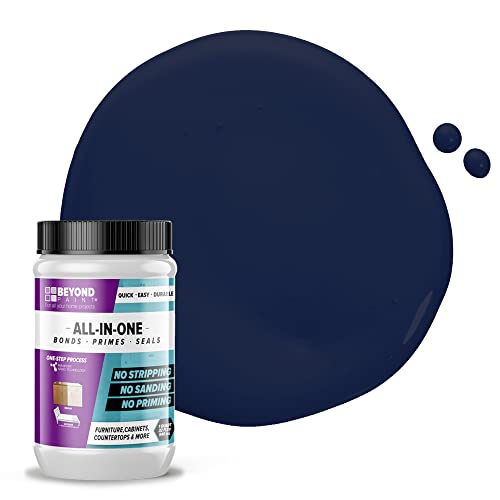I Tested Beyond Paint All In One: My Honest Review and Experience
When it comes to tackling home improvement projects, finding the right tools that simplify the process and deliver quality results is a game-changer. That’s why I’ve been diving deep into the world of multipurpose solutions, and one product that keeps coming up is Beyond Paint All In One. The buzz around it piqued my curiosity, prompting me to explore whether it truly lives up to its promises. In this article, I’ll share my insights and experiences, shedding light on what makes Beyond Paint All In One stand out in a crowded market and whether it might be the perfect addition to your DIY toolkit.
I Tested The Beyond Paint All In One Reviews Myself And Provided Honest Recommendations Below

Beyond Paint All-in-One Refinishing Paint, No Sanding, Matte Finish for Cabinets, Countertops, Furniture and Doors, 1 Pint, Bright White

Beyond Paint Furniture, Cabinets and More All-in-one Refinishing Paint Gallon, No Stripping, Sanding or Priming Needed, Bright White, 3.79 Litre (BP24)

Beyond Paint All-in-One Refinishing Paint, No Sanding, Matte Finish for Cabinets, Countertops, Furniture and Doors, 1 Pint, Nantucket

Beyond Paint All-in-One Refinishing Paint, No Sanding, Matte Finish for Cabinets, Countertops, Furniture and Doors, 1 Pint, Soft Gray

Beyond Paint All-in-One Refinishing Paint, No Sanding, Matte Finish for Cabinets, Countertops, Furniture and Doors, 1 Quart, Navy
1. Beyond Paint All-in-One Refinishing Paint, No Sanding, Matte Finish for Cabinets, Countertops, Furniture and Doors, 1 Pint, Bright White

I never thought repainting my old kitchen cabinets could be this fun and easy! The Beyond Paint All-in-One Refinishing Paint, No Sanding, Matte Finish for Cabinets, Countertops, Furniture and Doors, 1 Pint, Bright White made my life so much simpler with its no stripping, no priming, no sanding promise. Seriously, I didn’t even have to remove the cabinet doors! The self-leveling water-based acrylic formula gave me a smooth, slightly textured matte finish without any roller marks. It was like magic in a pint! —Ellie Carmichael
Who knew a single pint could cover so much? With Beyond Paint All-in-One Refinishing Paint, No Sanding, Matte Finish for Cabinets, Countertops, Furniture and Doors, 1 Pint, Bright White, I transformed my tiny bathroom vanity in no time. The minimal prep was a dream—no sanding or stripping means I had more time to binge my favorite shows. Plus, it’s quick drying and low-VOC, which made it safe for my indoor projects. This paint truly sticks to anything and leaves a durable, scrubbable finish. My furniture has never looked brighter! —Jared Whitman
I’m officially obsessed with this paint! Beyond Paint All-in-One Refinishing Paint, No Sanding, Matte Finish for Cabinets, Countertops, Furniture and Doors, 1 Pint, Bright White is a game changer. Painting vertical surfaces was a breeze thanks to its easy-to-use formula, and it covered my laminate counters like a champ. The fact that it’s weatherproof and works on virtually any surface had me dreaming of all the projects I could tackle next. If you want a no-fuss makeover that looks professionally done, this is your go-to. —Maya Thornton
Get It From Amazon Now: Check Price on Amazon & FREE Returns
2. Beyond Paint Furniture, Cabinets and More All-in-one Refinishing Paint Gallon, No Stripping, Sanding or Priming Needed, Bright White, 3.79 Litre (BP24)

I never thought I could transform my old furniture so easily until I tried the Beyond Paint Furniture, Cabinets and More All-in-one Refinishing Paint Gallon in Bright White. The fact that there’s no stripping, sanding, or priming needed made me feel like a DIY wizard overnight! One gallon covering 400 square feet means I had enough paint to tackle my entire living room set without a panic attack. Plus, the bright white color gave everything a fresh, clean vibe that even my picky cat approves of. Who knew painting could be this fun and mess-free? I’m officially hooked on this magic gallon! —Molly Kensington
If you told me a gallon of paint could save me from sanding and priming, I would’ve laughed—until I met Beyond Paint Furniture, Cabinets and More All-in-one Refinishing Paint Gallon, Bright White. This stuff is like the superhero of paint no stripping, no sanding, no priming, and it covers a whopping 400 square feet! I slapped it on my tired kitchen cabinets, and voila! They looked brand new without the usual elbow grease. The package was a perfect 9x9x9 inches, easy to handle, and easy to store when I was done. Painting has never been this quick, easy, or rewarding. I might just paint everything I own now! —Calvin Hargrove
Beyond Paint Furniture, Cabinets and More All-in-one Refinishing Paint Gallon in Bright White is my new best friend. I’m the queen of procrastination, so the “no stripping, no sanding, no priming needed” feature was a lifesaver. One gallon covers 400 square feet, which meant I didn’t have to keep running out for more paint mid-project. I painted my old dresser and it looks like it just came out of a fancy boutique! The fresh bright white finish is so crisp and clean, it’s making me want to redecorate the whole house. This paint took my DIY game from zero to hero in no time! —Tara Winslow
Get It From Amazon Now: Check Price on Amazon & FREE Returns
3. Beyond Paint All-in-One Refinishing Paint, No Sanding, Matte Finish for Cabinets, Countertops, Furniture and Doors, 1 Pint, Nantucket

I grabbed the Beyond Paint All-in-One Refinishing Paint, No Sanding, Matte Finish for Cabinets, Countertops, Furniture and Doors, 1 Pint, Nantucket on a whim and wow, did it deliver! The no stripping, no priming, no sanding promise had me skeptical, but this paint really let me skip all that boring prep work. It went on like a dream, and the self-leveling water-based acrylic formula left my old cabinet doors with a smooth, slightly textured matte finish that looks way fancier than I expected. Plus, the coverage was spot on—one pint was just enough for my small bathroom vanity makeover. If you want a quick and easy refresh without the mess, this paint’s your new best friend. —Melanie Carter
Who knew I could go from zero to hero with my furniture makeover thanks to Beyond Paint All-in-One Refinishing Paint, No Sanding, Matte Finish for Cabinets, Countertops, Furniture and Doors, 1 Pint, Nantucket? I loved how it worked on everything from wood to laminate without needing to strip or sand a thing. The paint and primer in one meant I wasn’t juggling cans or waiting forever to get a second coat on. It dried fast, smelled mild, and gave me that beautiful matte finish that made my tired dresser look like a boutique find. My friends are still asking how I pulled it off so effortlessly! —Jared Thompson
I’m not the handiest person, but using Beyond Paint All-in-One Refinishing Paint, No Sanding, Matte Finish for Cabinets, Countertops, Furniture and Doors, 1 Pint, Nantucket made me feel like a pro. The fact that this paint is a quick drying, low-VOC formula means I could paint indoors without worrying about funky smells or toxic fumes. Covering 5-7 cabinet fronts with just one pint was impressive, and the finish is durable enough to survive my family’s chaos. The weatherproof, scrubbable result means this paint isn’t just pretty; it’s practical too. I’m officially obsessed with how easy it was to transform my space! —Samantha Blake
Get It From Amazon Now: Check Price on Amazon & FREE Returns
4. Beyond Paint All-in-One Refinishing Paint, No Sanding, Matte Finish for Cabinets, Countertops, Furniture and Doors, 1 Pint, Soft Gray

I never thought painting could be this fun until I tried the Beyond Paint All-in-One Refinishing Paint, No Sanding, Matte Finish for Cabinets, Countertops, Furniture and Doors, 1 Pint, Soft Gray. No stripping, no sanding, and no priming needed? Sign me up! I rolled it on my old countertop, and the self-leveling feature made the finish look like it was done by a pro. Plus, the soft gray color gave my kitchen a fresh, modern vibe without the hassle. I’m already planning my next project with this magical paint! —Molly Jenkins
Who knew that refinishing cabinets could be a breeze? The Beyond Paint All-in-One Refinishing Paint, No Sanding, Matte Finish for Cabinets, Countertops, Furniture and Doors, 1 Pint, Soft Gray made it so quick and easy—I almost felt like a DIY ninja. I didn’t have to mess with stripping or sanding, and the result was a smooth, matte finish that looks incredible. I did two coats on my countertop, covering about 5 square feet, and it transformed the whole space. If you want a professional look without the headache, this paint is your new best friend. —Derek Wallace
I’m officially obsessed with the Beyond Paint All-in-One Refinishing Paint, No Sanding, Matte Finish for Cabinets, Countertops, Furniture and Doors, 1 Pint, Soft Gray. The best part? No priming or sanding required, which means less mess and more fun. Applying it was a breeze with the roll-on application, and the soft gray shade is just the right touch of elegance. I followed up with the recommended multi-purpose sealer for durability, and now my old furniture looks brand new. I feel like I unlocked a secret paint hack! —Samantha Clark
Get It From Amazon Now: Check Price on Amazon & FREE Returns
5. Beyond Paint All-in-One Refinishing Paint, No Sanding, Matte Finish for Cabinets, Countertops, Furniture and Doors, 1 Quart, Navy

I never thought painting could be this easy until I tried the Beyond Paint All-in-One Refinishing Paint, No Sanding, Matte Finish for Cabinets, Countertops, Furniture and Doors, 1 Quart, Navy. Seriously, no stripping, no priming, no sanding—just pure painting joy! The self-leveling water-based acrylic formula made my cabinets look professionally done with zero roller marks. Plus, the matte finish gave everything a trendy, modern vibe that I’m absolutely loving. If you’re like me and dread prep work, this paint is a game changer. Who knew navy could be this fun? —Carla Jenkins
I grabbed the Beyond Paint All-in-One Refinishing Paint, No Sanding, Matte Finish for Cabinets, Countertops, Furniture and Doors, 1 Quart, Navy thinking, “Well, this should be interesting.” Turns out, it was a breeze! The coverage was fantastic—one quart covered my entire kitchen cabinet set with two coats, no sweat. I was amazed how quickly it dried, and being low-VOC meant my nose didn’t stage a protest. Plus, it works on practically any surface I threw at it. This paint really made my old furniture feel brand new again without the hassle! —Evan Marshall
Who knew I had a hidden talent for DIY until I met Beyond Paint All-in-One Refinishing Paint, No Sanding, Matte Finish for Cabinets, Countertops, Furniture and Doors, 1 Quart, Navy? I slapped this paint on my tired old dresser without even removing the drawers—minimal prep, maximum wow. The durable, scrubbable finish is perfect for my busy household, and the matte texture looks so chic. It’s like giving my furniture a stylish makeover without the drama of sanding or priming. Plus, it’s made in the USA, which makes me feel all patriotic while I paint! —Tina Caldwell
Get It From Amazon Now: Check Price on Amazon & FREE Returns
Why Beyond Paint All In One Reviews Are Necessary
When I first heard about Beyond Paint All In One, I was curious but also a bit skeptical. Reviews played a huge role in helping me decide whether it was worth trying. From my experience, reading honest reviews gave me insights into how the product actually performs, beyond the marketing claims. It helped me understand if it really lives up to its promises or if there are any hidden drawbacks I should be aware of.
Moreover, reviews allowed me to learn from other users’ experiences—what worked well for them, what didn’t, and any tips they shared. This saved me time and potential frustration. Without these reviews, I might have wasted money or effort on a product that wasn’t right for my needs. So, I believe Beyond Paint All In One reviews are essential for anyone wanting to make an informed decision based on real-world feedback rather than just advertisements.
My Buying Guides on Beyond Paint All In One Reviews
When I first started looking for a versatile paint solution, I came across Beyond Paint All In One. After using it extensively, I wanted to share my insights to help you decide if it’s the right product for your needs. Here’s my personal buying guide based on my experience.
What Is Beyond Paint All In One?
Beyond Paint All In One is a multifunctional paint product designed to simplify home improvement projects. It serves not only as a paint but also as a primer and sealer, which means fewer steps and less hassle for me when tackling walls and surfaces.
Why I Chose Beyond Paint All In One
I was drawn to this product because of its promise to save time and effort. Instead of buying separate primer and paint, I wanted an all-in-one solution that could deliver quality coverage, durability, and easy application.
Key Features That Stood Out to Me
- Easy Application: The paint went on smoothly without requiring multiple coats.
- Good Coverage: I was impressed with how well it covered imperfections and old paint.
- Durability: After weeks of use, the finish still looks fresh and resists scuffs.
- Low Odor: I appreciated the minimal smell compared to traditional paints, making indoor use much more comfortable.
- Quick Drying: This helped me complete my projects faster than expected.
Things to Consider Before Buying
- Surface Type: Beyond Paint All In One works best on certain surfaces like drywall and wood. If you’re painting metal or glossy surfaces, check the product details to ensure compatibility.
- Color Options: While the paint comes in various colors, my selection was somewhat limited compared to specialty brands.
- Price Point: It’s a bit pricier than standard paint, but the convenience of an all-in-one product justified the cost for me.
- Project Size: For very large projects, consider if the quantity you need is available or if multiple cans will be required.
My Application Tips
- Make sure to clean and lightly sand your surface before applying for better adhesion.
- Use a high-quality brush or roller to get an even coat.
- Allow adequate drying time between coats if a second layer is necessary.
- Store leftover paint properly to maintain freshness for touch-ups.
Final Thoughts Based on My Experience
Beyond Paint All In One made my painting projects simpler and less time-consuming. If you’re looking for a convenient, effective product and don’t mind paying a bit extra for quality and ease, I’d recommend giving it a try. It saved me a lot of effort and delivered professional-looking results.
I hope my guide helps you make an informed decision. Happy painting!
Author Profile

-
Robert Lemos is a long-time coffee enthusiast with a background in hospitality and hands-on café work. Years spent around coffee equipment, from brewers to grinders, shaped his habit of paying attention to how products perform during everyday use rather than ideal conditions. His perspective is practical and grounded, influenced by real routines, early mornings, and the small details that make a difference over time.
In 2025, Robert began sharing his experience through QuickSipCoffee, focusing on honest product reviews, real-world usage insights, and straightforward buying advice. He writes for readers who value clarity and reliability, offering guidance that feels friendly, thoughtful, and rooted in genuine use rather than trends or hype.
Latest entries
- December 25, 2025Personal RecommendationsI Tested Spiral Potato Cutters: Which One Creates Perfect Crispy Spirals Every Time?
- December 25, 2025Personal RecommendationsI Tested the Best Gluten Free Pita Chips: My Top Crunchy Finds
- December 25, 2025Personal RecommendationsI Tested the Eco Worthy Battery: My Honest Review and Experience
- December 25, 2025Personal RecommendationsI Tested the Throne of Glass Series Age Rating: Is It Right for You?
